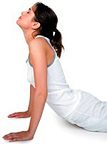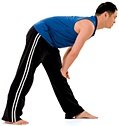Good Spinal Health Key to Feeling Great
Movement Enhances Your Quality of Life.
By Donald Petersen Jr.
While we usually talk about the spine as a single part of the body, it's much more than that. Your spine allows you to do almost everything you do.
Proper spinal function allows you to do things well - and most of the time, pain-free. Poor spinal function forces you to do things poorly or not at all, not to mention the agony spinal distress can cause.
Consider for a moment everything you did today. Almost every movement you made, from getting out of bed in the morning until you got back into bed at night, required your spine to work in very complex ways that you've probably never thought twice about. Not only did your spine perform delicate mechanical functions, but it also facilitated the majority of your nerve function, another aspect of proper spinal function that most people never
consider ... until there's a problem.
 Your Spine
Your Spine
Your spine consists of 26 bones, called vertebrae, which run from the "atlas" your head sits on to your "coccyx" or tailbone. These vertebrae essentially stack one on top of the other in your vertebral column, floating on intervertebral discs. Every other bone in your body is attached in some way to your spinal column.
When you move, your spinal column moves in some combination of four ways:
 FLEXION
FLEXION
- flexion - bending forward;
- extension - bending backward;
- lateral bending - bending from side-to-side;
- rotation - twisting.
If your spine were just one solid bone, it couldn't perform any of the variety of body movements; but as a stack of 26 bones, your spinal column can twist and bend to accommodate your every activity. This is accomplished by each spinal segment doing its job. When your spine moves, each movement of your vertebrae is choreographed through the rest of your body via a wonderfully designed system of muscles and ligaments that work together.

